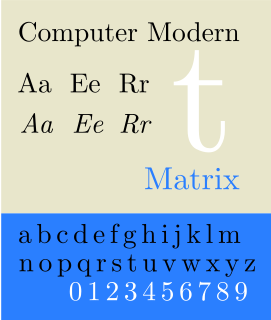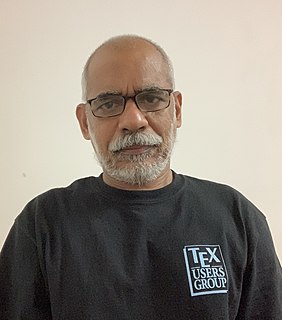Related Research Articles
The Comprehensive Perl Archive Network (CPAN) is a repository of over 250,000 software modules and accompanying documentation for 39,000 distributions, written in the Perl programming language by over 12,000 contributors. CPAN can denote either the archive network or the Perl program that acts as an interface to the network and as an automated software installer. Most software on CPAN is free and open source software.

LaTeX is a software system for document preparation. When writing, the writer uses plain text as opposed to the formatted text found in "What You See Is What You Get" word processors like Microsoft Word, LibreOffice Writer and Apple Pages. The writer uses markup tagging conventions to define the general structure of a document, to stylise text throughout a document, and to add citations and cross-references. A TeX distribution such as TeX Live or MiKTeX is used to produce an output file suitable for printing or digital distribution.
TeX, stylized within the system as TeX, is a typesetting system which was designed and written by Donald Knuth and first released in 1978. TeX is a popular means of typesetting complex mathematical formulae; it has been noted as one of the most sophisticated digital typographical systems.
OpenType is a format for scalable computer fonts. It was built on its predecessor TrueType, retaining TrueType's basic structure and adding many intricate data structures for prescribing typographic behavior. OpenType is a registered trademark of Microsoft Corporation.

The device independent file format (DVI) is the output file format of the TeX typesetting program, designed by David R. Fuchs and implemented by Donald E. Knuth in 1982. Unlike the TeX markup files used to generate them, DVI files are not intended to be human-readable; they consist of binary data describing the visual layout of a document in a manner not reliant on any specific image format, display hardware or printer. DVI files are typically used as input to a second program which translates DVI files to graphical data. For example, most TeX software packages include a program for previewing DVI files on a user's computer display; this program is a driver. Drivers are also used to convert from DVI to popular page description languages and for printing.
BitTorrent is a communication protocol for peer-to-peer file sharing (P2P), which enables users to distribute data and electronic files over the Internet in a decentralized manner.

Computer Modern is the original family of typefaces used by the typesetting program TeX. It was created by Donald Knuth with his Metafont program, and was most recently updated in 1992. Computer Modern, or variants of it, remains very widely used in scientific publishing, especially in disciplines that make frequent use of mathematical notation.

ΧyMTeΧ is a macro package for TeX which renders high-quality chemical structure diagrams. Using the typesetting system, the name is styled as XϒMTeX. It was originally written by Shinsaku Fujita. Molecules are defined by TeX markup.
Jim Hefferon is a Professor of Mathematics at Saint Michael's College. He is known for his award-winning textbook on linear algebra that is available for free download, with LaTeX source, and for his activity in the TeX community.

TeX Live is a cross-platform, free software distribution for the TeX typesetting system that includes major TeX-related programs, macro packages, and fonts. It is the replacement of its no-longer supported counterpart teTeX. It is now the default TeX distribution for several Linux distributions such as openSUSE, Fedora, Debian, Ubuntu, Termux and Gentoo. Other Unix operating systems like OpenBSD, FreeBSD and NetBSD have also converted from teTeX to TeX Live.

The International Music Score Library Project (IMSLP), also known as the Petrucci Music Library after publisher Ottaviano Petrucci, is a subscription-based digital library of public-domain music scores. It includes public domain and licensed recordings to allow for study by ear. The project, which uses MediaWiki software, has uploaded more than 495,000 scores and 59,000 recordings of more than 152,000 works by 18,000 composers. IMSLP has both an iOS app and an Android app.

PGF/TikZ is a pair of languages for producing vector graphics from a geometric/algebraic description, with standard features including the drawing of points, lines, arrows, paths, circles, ellipses and polygons. PGF is a lower-level language, while TikZ is a set of higher-level macros that use PGF. The top-level PGF and TikZ commands are invoked as TeX macros, but in contrast with PSTricks, the PGF/TikZ graphics themselves are described in a language that resembles MetaPost. Till Tantau is the designer of the PGF and TikZ languages. He is also the main developer of the only known interpreter for PGF and TikZ, which is written in TeX. PGF is an acronym for "Portable Graphics Format". TikZ was introduced in version 0.95 of PGF, and it is a recursive acronym for "TikZ ist kein Zeichenprogramm".
In digital typography, the New Typesetting System (NTS) is a discontinued reimplementation of the typesetting system TeX in Java. The specific aims of the project were to continue the tradition of Donald Knuth's TeX by providing a first-class typesetting software which is both portable and available free of charge. But whereas TeX is now frozen due to maximum stability, NTS was intended to remain flexible and extensible.
TeX4ht is a configurable converter capable of translating TeX and LaTeX documents to HTML and certain XML formats. Most notably, TeX4ht serves for converting (La)TeX documents to formats used by word processors. It was developed by Eitan M. Gurari.

MathJax is a cross-browser JavaScript library that displays mathematical notation in web browsers, using MathML, LaTeX and ASCIIMathML markup. MathJax is released as open-source software under the Apache License.
A supercomputer operating system is an operating system intended for supercomputers. Since the end of the 20th century, supercomputer operating systems have undergone major transformations, as fundamental changes have occurred in supercomputer architecture. While early operating systems were custom tailored to each supercomputer to gain speed, the trend has been moving away from in-house operating systems and toward some form of Linux, with it running all the supercomputers on the TOP500 list in November 2017. In 2021, top 10 computers run for instance Red Hat Enterprise Linux (RHEL), as in the fastest one, or some variant of it or other Linux distribution e.g. Ubuntu.
Mirror sites or mirrors are replicas of other websites or any network node. The concept of mirroring applies to network services accessible through any protocol, such as HTTP or FTP. Such sites have different URLs than the original site, but host identical or near-identical content. Mirror sites are often located in a different geographic region than the original, or upstream site. The purpose of mirrors is to reduce network traffic, improve access speed, ensure availability of the original site for technical or political reasons, or provide a real-time backup of the original site. Mirror sites are particularly important in developing countries, where internet access may be slower or less reliable. The maintainers of some mirrors choose not to replicate the entire contents of the upstream server they are mirroring because of technical constraints, or selecting only a subset relevant to their purpose, such as software written in a particular programming language, runnable on a single computer platform, or written by one author. These sites are called partial mirrors or secondary mirrors.

Sebastian Patrick Quintus Rahtz (SPQR) was a British digital humanities information professional.

Language Science Press (LSP) is an open access scholarly publishing house specializing in linguistics formally set up in 2014. Language Science Press publishes books on a central storage and archiving server in combination with print on-demand services. Books are published under the Creative Commons CC-BY license as a standard. As of May 2021, the catalog lists 174 books in English, German, Portuguese, Spanish, or Chinese. A total of 30 books are published every year, including monographs and edited volumes.

Chandroth Vasudevan Radhakrishnan aka CV Radhakrishnan aka CVR, is an Indian free software developer, entrepreneur and the Founder of River Valley Technologies. He is also one of the founding members of TeX Users Group in India.
References
- ↑ Jim Hefferon. tug.ctan.org offline . Posting. comp.text.tex, 2011-01-30. Retrieved 2013-01-19.
- ↑ Steve Peter. January 2013 TUG news. Posting. texhax, 2013-01-19. Retrieved 2013-01-21.